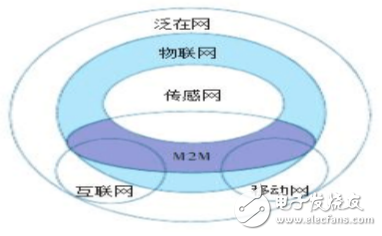From the technical point of view, the development of mobile communication technology and the Internet of Things
The Internet of Things can be technically divided into three layers: the sensing layer, the communication layer, and the application layer. In the communication layer, the data and information collected by the sensing layer need to be communicated and transmitted securely and reliably. The short-range wireless communication technology has been introduced in the article "Common Analysis of Near-Internet Communication Technology of Internet of Things", this paper will introduce mobile communication. Technological development and the Internet of Things. Near-field wireless communication is important for the Internet of Things. However, because the Internet of Things is based on a variety of network convergence, its information nodes are characterized by extensiveness and mobility. Therefore, mobile communication technology is a networking technology. The same is true for the development of the Internet of Things. Mobile communication refers to both sides of communication, at least one of which is communication during the movement, including communication between fixed points and moving points, moving points and moving points. The relationship between the concept of the Internet of Things and other networks First of all, science development from 1G to 4G 1G In 1986, the first mobile communication system was born in Chicago, USA, using analog signal transmission, and the analog type represented the use of analog FM modulation in wireless transmission. The main system of 1G is AMPS, in addition to NMT and TACS, there are points of A network and B network. The big "big brother" is all the rage. 2G Compared with 1G networks that can only be applied to general voice transmission, with low voice quality, unstable signals, and insufficient coverage, the second generation mobile communication has a high degree of confidentiality, and the system capacity is also increasing. The first generation of mobile phones can also access the Internet. With the birth of 2G, the competition for mobile communication standards has begun. 2G mainstream network GSM: Global System for Mobile CommunicaTIon is the most widely used mobile phone standard. The biggest difference is that its signaling and voice channels are digital. of. TDMA: Time Division Multiple Access (TImeDivision MulTIple Access) divides time into periodic frames. Each frame is divided into several time slots to send signals to the base station. Under the condition of satisfying timing and synchronization, the base station The signals of the mobile terminals can be received in each time slot without confusion. 3G As people's demand for mobile networks continues to increase, the third generation of mobile communication networks has opened a new era of mobile communications. The high frequency and stable transmission of 3G networks makes video telephony and large amounts of data transmission more common. Among them, CDMA is the technical basis of the third generation mobile communication system. The CDMA system shows great development potential due to its simple frequency planning, large system capacity, high frequency reuse coefficient, strong anti-multipath capability, good communication quality, soft capacity and soft handover. 4G The 4G wireless cellular phone protocol is a technology product that integrates 3G and WLAN and can transmit high-quality video images and image transmission quality comparable to that of high-definition television. The 4G system can download at 100Mbps, which is 2000 times faster than dial-up Internet access, and the upload speed can reach 20Mbps. 4G's main network standard LTE is a global standard based on OFDMA technology and developed by the 3GPP organization, including TDD (Time Division Duplex) and FDD (Frequency Division Duplex). The similarity is 90%, and the difference is small. . Application of mobile communication system in the Internet of Things Mobile communication systems generally consist of mobile terminals, transmission networks, and network management and maintenance. Therefore, the application of mobile communication in the Internet of Things mainly includes the following aspects: (1) The mobile terminal of the mobile communication system has the network information node moving and realizes the communication anytime and anywhere, and has the commonality with the sensing terminal of the Internet of Things, and the mobile communication terminal can completely become the communication component of the Internet of Things information node terminal. (2) The mobile communication network has mature technology, extensive coverage, and can be used as an information transmission network of the Internet of Things. (3) The mobile network management and maintenance platform has mature management and maintenance functions to ensure transmission security and information security. The Internet of Things can use the mobile network management platform to implement related management and maintenance functions for the Internet of Things. Featuring level VI energy efficiency and meet IEC/EN/UL 62368 safety standards for ITE/AV equipment, the external universal power adapter accepts the output power rating of 65W with universal AC input voltage range from 100-240VAC and provides 3 Years warranty. These series power adapters use PC flame retardant material housing, all materials conform to the international environment protection standard. Protections for over voltage, over current and short circuit are also included. 15v dc regulated power supply,15v DC adaptor,110V 220V 230v 240V to 15v power adaptor,universal input 15v 3a adaptor Shenzhenshi Zhenhuan Electronic Co Ltd , https://www.szzhpower.com
